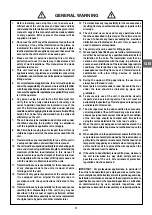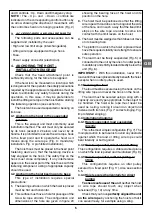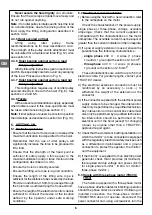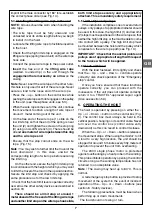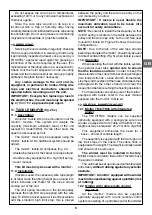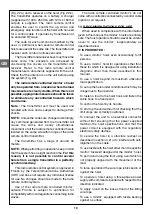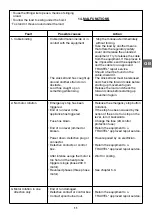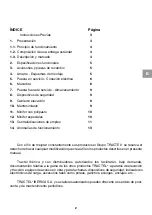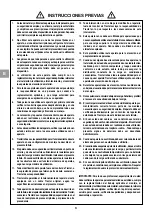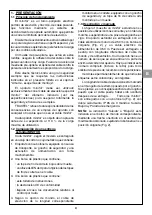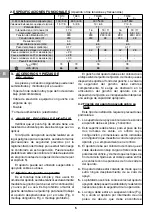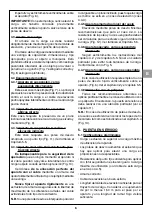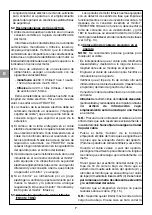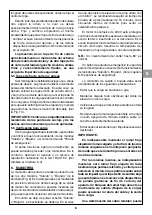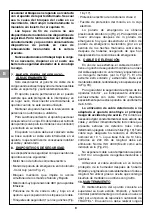
6
Never secure the hoist rigidly on a structure.
Ensure that the wire rope strands move freely and
do not rub against anything.
Note : If an idler pulley is interposed to hoist the load
on a slanted plane, due to the driving action of the
load, apply the lifting configuration described in
section 4.4.3.
4.4.5 Hoist secured on floor
Lifting using idler pulley. Same
recommendations as for case described in 4.4.4.
The strength of the pulley and its attachment must
be calculated for a double load force (Fig. 12). Also
see section 5.5.
4.4.6 Hoist bearing against surface, load
freely suspended
Strictly follow the instructions given in section 4.2.
and 5.5. Be especially careful to avoid any swinging
of the load. Proceed as shown in Fig. 5.
4.4.7 Hoist bearing against surface, load not
freely suspended
This configuration requires use of an idler pulley
secured directly in line with the hoist (Fig. 6). See
sections 4.2 and 5.5.
4.4.8 Tackle
All the above recommendations apply, especially
when tackle is used. In this case, special care must
be taken when tensioning (see section 11).
Note: If idler pulleys are used, be careful to position
the limit stops as described in section 5.4 (Fig. 13).
5. SETTING UP
5.1 Preliminary checks
• Ensure that the load or force does not exceed the
maximum utilization load specified for the hoist.
• Remember that the use of idler pulleys will
significantly increase the force to be produced to
lift a load.
• Ensure that the strength of the fixed point is
sufficient to safely apply a force equal to the
maximum utilization load (or twice this load in the
configuration described in 4.4.5).
• Ensure the hoist is correctly secured.
• Ensure the lifting wire rope is in good condition.
• Ensure the length of the lifting wire rope is
sufficient for the distance to be covered by the load.
Provide an additional 1.50m for passage through
the hoist and a sufficient length of loose strand.
• Ensure the length of the electrical control cable is
sufficient to connect the device at the location
defined by the operator under safe working
conditions.
5.2 Electrical recommendations
1) Before using the hoist with a new connection, refer
to the nameplate on the motor.
Check the characteristics of the power supply,
single phase or three-phase, voltage, available
amperage. Check that the current supplied is
compatible with the characteristics on the motor
nameplate. The available current must be equal or
greater than the current indicated on the nameplate.
2) If a power supply extension is used, ensure the
potential has the following characteristics :
- single phase 230 V. : 3 wires (1 phase,
1 neutral, 1 ground)with section of 2.5 mm2.
- three-phase 400 V. : 4 wires (3 phases,
1 ground) with section of 2.5 mm2.
These characteristics are valid for up to 50 m of
electrical cable. For greater lengths, contact your
TRACTEL
®
dealer.
3) The electrical extension connection must be
reinforced by an accessory (« sock ») to
withstand the weight of the extension at the
connector.
4) If the connector supplied with the electrical power
supply cable is to be changed, this intervention
must only be performed by a qualified technician.
Any intervention on the control box cable must
also only be performed by a qualified technician.
No intervention should be performed on the
electrical unit of the hoist (except for changing
a fuse), by anyone other than a TRACTEL
®
-
approved repair agent.
5) Check that the worksite or building installation on
which the minifor
™
is to be connected is equipped
with the regulatory electrical safety devices such
as a differential circuit-breaker and a ground
connection to protect the operator, the minifor
™
and the equipment.
6) If the minifor
™
is supplied from an electric power
generator, check that it provides (at minimum),
the required startup voltage and power. (6 kVa
for single-phase minifor
™
, 8 kVa for minifor
™
three-phase minifor
™
).
5.3 Hoists with three-phase motor (TR30S /
TR50)
The hoists equipped with a three-phase motor
have a phase direction detector inhibiting operation
should the phase order be inverted. If following an
inverted connection, the three-phase minifor
™
TR30S/TR50 does not operate, disconnect the
power connector and, using a screwdriver, turn the
GB



